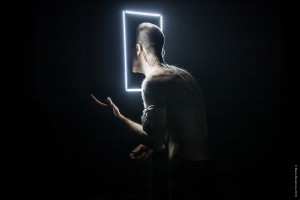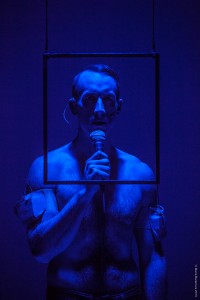With a flash of bright light and a bone-rattling buzz, Youarenowhere begins with an assault on the senses. The show's creator and star, Andrew Schneider, enters the performance space seeming as disoriented as his audience. He tries to find his feet in reality, but this is no small task, since a taut thread of existential anxiety may be the only thing holding Youarenowhere together. Will this hypermediated anxiety destroy Schneider? Will it destroy us all? Where are we, anyway? The answer, of course, is Youarenowhere. Schneider's intermedial mashup avoids letting the audience get comfortable in any genre, morphing from an existential diatribe into a TED Talk on metaphysics. From there, it becomes a magic show and an experimental dance piece. The accelerated and indeterminate nature of Youarenowhere could not succeed without its seamless choreography of sound, lighting and tech cues. This design is expertly executed by the show's crew: technical director Karl Franklin Allen, light/video supervisor Daniel Jackson, sound supervisor Bobby McElver and stage manager Alessandra Calabi. Consider the work of these technicians a remedy for theatergoers who haven't had their breath taken away in a long time.
The hyper-technological and multi-genre performance art style Schneider draws from is not entirely new, and he certainly cites his sources. Indeed, the citational nature of network technology—with its wikis and file sharing and retweeting—creates many opportunities for reference within performance. Considering the breakneck pace at which most of Youarenowhere progresses, it's impossible to catch all the references or to pursue each philosophical abyss opened up by Schneider in his tweaky, nervous manner. Schneider splices songs by Rihanna and Robyn in with classical music and an especially touching rendition of Ricky Nelson's "Lonesome Town," awash in cobalt blue.
For followers of The Wooster Group, the influence of Schneider's seven years of membership in that company will be readily apparent. In one sequence, a video projection of a young Schneider (at a filmed audition) ghosts the present-day Schneider. He recites a monologue with his past self with hardly a flaw. The "hardly" should be emphasized here since it is the ever-diminishing distinction between man and machine that inspires the technological and choreographic design of this moment. There is more philosophical exploration to be done on this subject, however, in the script of the play.
Though the sound, lighting and tech design of Youarenowhere formally performs the ever-present tension between (and fusion of) technology and humanity, this is precisely where the written script falls short. There exists a lacuna between Schneider's buggy, technologically mediated physicality and the words he actually says. Schneider lectures us on metaphysics and love, but he doesn't offer much tangible insight into the effects of technology and the Internet on the human experiences of love, loss and addiction. Youarenowhere's only missing piece is its reluctance to verbally process the very difficult and very daunting possibility that we are becoming machines and that machines are becoming us. Again, Schneider physically performs this tension, but his monologues tend to skirt the issue.
Schneider muses that "we exist in each other's realities. But maybe not in the way that we think that we do." When theater succeeds in calling upon us to question the very nature of our existence, it is worth seeing. It seems prudent to forewarn sensitive audiences of the bright light and loud sound in Youarenowhere. Furthermore, people with a history of anxiety or panic attacks should take note of the show's intense pacing and content. That being said, Youarenowhere could be extremely cathartic for the anxious, the lovelorn and the grieving. In provoking both awe and intense existential questioning, Youarenowhere (somehow) simultaneously satisfies one's inner child and cynic. It should not be missed.
Youarenowhere runs until April 3 at 3LD Art & Technology Center (80 Greenwich St. between Edgar and Rector Sts.) in the Financial District. Tickets range from $15-$35 and are available here or by calling 3LD Art & Technology Center at 212-645-0374.











